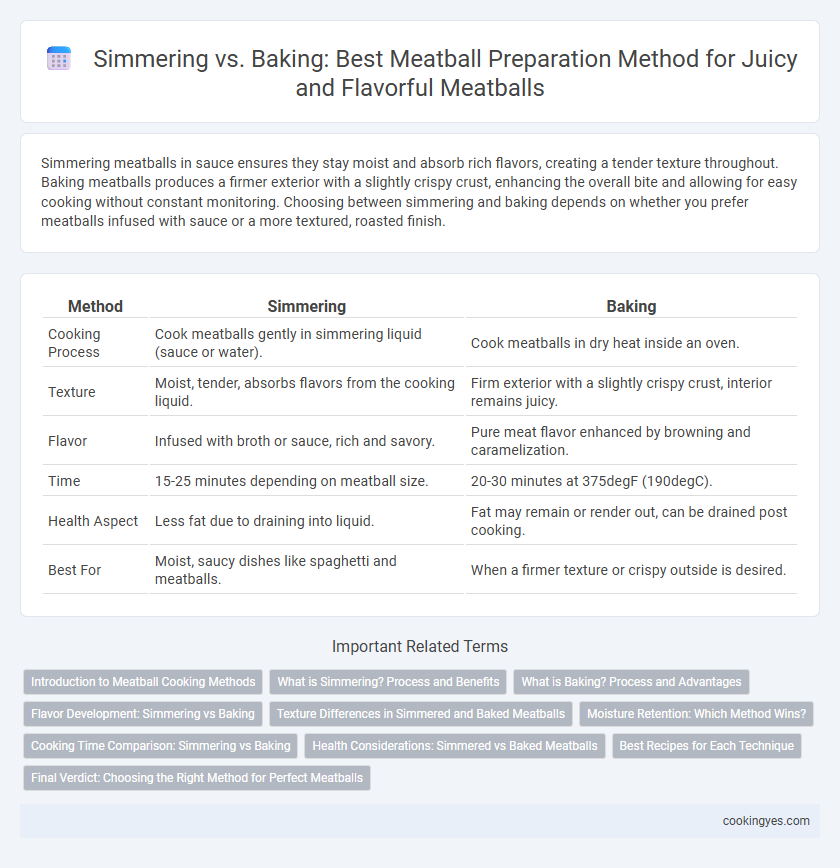Simmering meatballs in sauce ensures they stay moist and absorb rich flavors, creating a tender texture throughout. Baking meatballs produces a firmer exterior with a slightly crispy crust, enhancing the overall bite and allowing for easy cooking without constant monitoring. Choosing between simmering and baking depends on whether you prefer meatballs infused with sauce or a more textured, roasted finish.
Table of Comparison
| Method | Simmering | Baking |
|---|---|---|
| Cooking Process | Cook meatballs gently in simmering liquid (sauce or water). | Cook meatballs in dry heat inside an oven. |
| Texture | Moist, tender, absorbs flavors from the cooking liquid. | Firm exterior with a slightly crispy crust, interior remains juicy. |
| Flavor | Infused with broth or sauce, rich and savory. | Pure meat flavor enhanced by browning and caramelization. |
| Time | 15-25 minutes depending on meatball size. | 20-30 minutes at 375degF (190degC). |
| Health Aspect | Less fat due to draining into liquid. | Fat may remain or render out, can be drained post cooking. |
| Best For | Moist, saucy dishes like spaghetti and meatballs. | When a firmer texture or crispy outside is desired. |
Introduction to Meatball Cooking Methods
Simmering meatballs in sauce allows for even cooking while infusing flavors directly into the meat, resulting in a tender texture. Baking meatballs offers a hands-off approach that creates a caramelized exterior and a firmer bite. Both methods influence the meatball's moisture retention and flavor profile, crucial factors in meatball preparation.
What is Simmering? Process and Benefits
Simmering meatballs involves cooking them gently in hot liquid just below boiling point, typically between 185degF to 205degF (85degC to 96degC), allowing even heat distribution and moisture retention. This process ensures tender, juicy meatballs infused with broth or sauce flavors, minimizing the risk of drying out compared to baking. Simmering also reduces fat content as excess oils render into the cooking liquid, enhancing overall taste and texture.
What is Baking? Process and Advantages
Baking meatballs involves cooking them in an oven at a consistent temperature, typically between 350degF to 400degF, which allows for even heat distribution and caramelization on the exterior. This dry-heat method helps achieve a crispy outer layer while retaining juicy, tender interiors without added fat from frying. Baking is advantageous for its hands-off convenience, uniform cooking, and reduced oil usage, making it a healthier alternative to pan-frying or simmering meatballs.
Flavor Development: Simmering vs Baking
Simmering meatballs in sauce allows flavors to meld deeply, as the slow, moist heat infuses the meat with surrounding spices and herbs, resulting in a tender, juicy texture. Baking meatballs creates a caramelized, browned exterior through dry heat, intensifying savory notes and adding a slightly crisp texture without diluting flavors. Both methods uniquely enhance flavor profiles, with simmering emphasizing moisture and richness, while baking highlights texture and concentrated taste.
Texture Differences in Simmered and Baked Meatballs
Simmering meatballs results in a tender, moist texture due to gentle cooking in liquid, which allows flavors to meld and prevents drying out. Baked meatballs develop a firmer, slightly crispy exterior with a denser interior, thanks to direct dry heat exposure. Texture differences are crucial: simmered meatballs offer juiciness and softness, while baked meatballs provide a more structured bite and caramelized surface.
Moisture Retention: Which Method Wins?
Simmering meatballs in sauce preserves moisture by gently cooking them in liquid, resulting in tender, juicy textures less prone to drying out. Baking exposes meatballs to dry heat, which can lead to moisture loss but allows for a crispy exterior. For optimal moisture retention, simmering is generally preferred due to its consistent, low-temperature cooking environment that seals in juices.
Cooking Time Comparison: Simmering vs Baking
Simmering meatballs typically takes 20 to 30 minutes, allowing for gentle cooking that retains moisture and infuses flavors. Baking meatballs usually requires 15 to 25 minutes at 375degF (190degC), resulting in a firmer texture and a browned exterior. The choice between simmering and baking depends on desired texture and cooking efficiency, with baking often being faster but less moist.
Health Considerations: Simmered vs Baked Meatballs
Simmered meatballs retain moisture without added fats, reducing calorie content and promoting heart health by avoiding excess oil. Baking meatballs allows fat to drain away, decreasing saturated fat intake and resulting in a leaner protein option. Both methods offer health benefits, but simmering preserves tenderness while baking enhances texture with lower fat absorption.
Best Recipes for Each Technique
Simmering meatballs in a rich tomato sauce ensures they remain moist while absorbing deep, savory flavors, ideal for classic Italian dishes like spaghetti and meatballs. Baking meatballs in the oven allows for a crispy exterior and even cooking, making them perfect for recipes like Swedish meatballs or meatball sliders. Choosing the right technique depends on desired texture and flavor intensity, with simmering offering tenderness and baking delivering a firmer bite.
Final Verdict: Choosing the Right Method for Perfect Meatballs
Simmering meatballs in sauce ensures thorough cooking and infuses rich flavors, resulting in moist, tender bites, while baking offers a crisp exterior with a firmer texture by cooking meatballs evenly in dry heat. For juicy, melt-in-your-mouth meatballs ideal in pasta sauces, simmering is optimal; when seeking a healthier, less greasy option with a golden crust, baking is preferred. Selecting between simmering and baking depends on desired texture and flavor intensity, making each method suitable for specific culinary preferences and dishes.
Simmering vs Baking for meatball preparation Infographic

 cookingyes.com
cookingyes.com